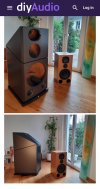Hi
DIY from a distance, seems like a good solution, even an ideal one... until you try .. for anything. The results are usually very, very far from what you
saw on the web, magazines or YouTube.
To be blunt END Game DIY requires a level of skill and knowledge that few people, audiophile or otherwise possess.
... Let me go on...
Cost and Time:
The cost of material, the so-called BOM (Bill of Material): The cost of parts required to make something... Well, after a few mishaps one quickly realizes, that the BOM is, perhaps, more the mere listing (and cost) of parts and accessories.. Most people, unless you have tried, do not realize it also involves parts, tools and sometimes, truly tangential and/or peripheral items.. such as solvent, glue, cleaners, accessories-specific tools... those tend to come when least expected... Sometimes you need a new fan in your shop because the solvent you use requires it... or ... Different drill bits for the wood type or grinder blades or ...
Finish
The level of finish, one finds routinely in, even inexpensive products, say a $200.oo loudspeaker, is beyond most mere mortal, unless they are already well-versed hobbyists in woodworking or metalworking or other craft, 3-D printing for example; else? Truly poor results ... Good finishing takes a long time, requires practice, patience and knowledge
And the cost. Even for something as basic as a sealed subwoofer: Relating my own experience. I am not a woodworker, my experience in woodworking is below zero; yet, these seemed like a good solution for my 3rd subwoofer:
There are some flat-packed subwoofer kits on Parts Express. The one I was fixated on:
Good subwoofer with a 15 inches driver, the kit comes in CNC cuts. So all you need to do is assemble it, @ $360.00 complete and shipped? Super!
... You need these too:
Wood Glue.. About $20, total
Polyfill acoustic stuffing ... About $100.00
Feet for the cabinet.... About $30.00
Binding posts.... about $20.oo
Wires .. frankly anything 12 ga. ... $5.oo ?? Less?
Wood clamps for the required size ... The big surprise for me you need 8.. They better be good
Yep! before you know, a good set of 40 inches clamps is about $60/ pair fora total of $250.00, yep!
You decide to go "natural" so won't finish it... it stays with the wood it came in.. finger marks and glue marks on it? No problem? $0.00 for finish.
You then need an amp for this thing, 500 watts of more amp... No worry, Parts Express has those, some at as low as $250.00. Excellent.
Then you have to mount this amp in the box, It doesn't have the proper cut-out.. You have a shop make it for you, $50.oo? More?
...
At the end, your subwoofer cost you, a bit
over $1300.oo ... Plus your time (
which you gave freely, who are we to account for it?  )
). You are happy... but on the commercial side, you could have bought an SVS SB-3000 for $1200.oo in piano black, no less,
with a Bluetooth App. , or a Rythmik F15 HP for $1600.oo or ... These are likely to perform at least as well, perhaps better, much better,
measurably better than your DIY ? Perhaps?? I'll grant that...
...
My own conclusion and advice:
Don't even think about DIY . It is a fool errant. Unless you are/were already deeply versed in
speaker DIY.
Happy holiday!
Peace.
P.S.
Edited for clarity


